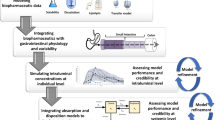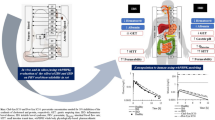ABSTRACT
Purpose
To outline and test a new modeling approach for prospective predictions of absorption from newly developed modified release formulations based on in vivo studies of gastro intestinal (GI) transit, drug release and regional absorption for the investigational drug AZD0837.
Methods
This work was a natural extension to the companion article “A semi-mechanistic model to link in vitro and in vivo drug release for modified release formulations”. The drug release model governed the amount of substance released in distinct GI regions over time. GI distribution of released drug substance, region specific rate and extent of absorption and the influence of food intake were estimated. The model was informed by magnetic marker monitoring data and data from an intubation study with local administration in colon.
Results
Distinctly different absorption properties were characterized for different GI regions. Bioavailability over the gut-wall was estimated to be high in duodenum (70%) compared to the small intestine (25%). Colon was primarily characterized by a very slow rate of absorption.
Conclusions
The established model was largely successful in predicting plasma concentration following administration of three newly developed formulations for which no clinical data had been applied during model building.





Similar content being viewed by others
REFERENCES
Casey DL, Beihn RM, Digenis GA, Shambhu MB. Method for monitoring hard gelatin capsule disintegration times in humans using external scintigraphy. J Pharm Sci. 1976;65(9):1412–3.
Digenis GA, Sandefer EP, Page RC, Doll WJ. Gamma scintigraphy: An evolving technology in pharmaceutical formulation development - Part 1. Pharm Sci Technol Today. 1998;1(3):100–7.
Digenis GA, Sandefer EP, Page RC, Doll WJ. Gamma scintigraphy: An evolving technology in pharmaceutical formulation development - Part 2. Pharm Sci Technol Today. 1998;1(4):160–5.
Weitschies W, Blume H, Mönnikes H. Magnetic marker monitoring: High resolution real-time tracking of oral solid dosage forms in the gastrointestinal tract. Eur J Pharm Biopharm. 2009;74(1):93–101.
Weitschies W, Kosch O, Mönnikes H, Trahms L. Magnetic Marker Monitoring: An application of biomagnetic measurement instrumentation and principles for the determination of the gastrointestinal behavior of magnetically marked solid dosage forms. Adv Drug Deliv Rev. 2005;57(8):1210–22.
Bergstrand M, Söderlind E, Weitschies W, Karlsson MO. Mechanistic modeling of a magnetic marker monitoring study linking gastrointestinal tablet transit, in vivo drug release, and pharmacokinetics. Clin Pharmacol Ther. 2009 Jul;86(1):77–83.
Sutton SC. The use of gastrointestinal intubation studies for controlled release development. Br J Clin Pharmacol. 2009;68(3):342–54.
Nyberg L, Mansson W, Abrahamsson B, Seidegard J, Borga O. A convenient method for local drug administration at predefined sites in the entire gastrointestinal tract: experiences from 13 phase I studies. Eur J Pharm Sci. 2007 Apr;30(5):432–40.
Olsson SB, Rasmussen LH, Tveit A, Jensen E, Wessman P, Panfilov S, et al. Safety and tolerability of an immediate-release formulation of the oral direct thrombin inhibitor AZD0837 in the prevention of stroke and systemic embolism in patients with atrial fibrillation. Thromb Haemost. 2010;103(3):604–12.
Johansson S, Cullberg M, Eriksson UG, Elg M, Dunér K, Jensen E, et al. Single-dose pharmacokinetics, pharmacodynamics and safety of AZD0837, a novel oral direct thrombin inhibitor, in young healthy male subjects. Int J Clin Pharmacol Ther. 2011;49(4):258–67.
Lip GYH, Rasmussen LH, Olsson SB, Jensen EC, Persson AL, Eriksson U, et al. Oral direct thrombin inhibitor AZD0837 for the prevention of stroke and systemic embolism in patients with non-valvular atrial fibrillation: A randomized dose-guiding, safety, and tolerability study of four doses of AZD0837 vs. vitamin K antagonists. Eur Heart J. 2009;30(23):2897–907.
Bergstrand M, Söderlind E, Eriksson UG, Weitschies W, Karlsson MO. A mechanistic model to link in vitro and in vivo drug release for modified release formulations. [unpublished companion manuscript].
Beal SL, Sheiner LB, Boeckmann AJ. NONMEM User’s Guides. Ellicot City: MD: Icon Development Solutions; 1989–2006.
Lindbom L, Ribbing J, Jonsson EN. Perl-speaks-NONMEM (PsN)–a Perl module for NONMEM related programming. Comput Methods Programs Biomed. 2004 Aug;75(2):85–94.
Lindbom L, Pihlgren P, Jonsson EN. PsN-Toolkit–a collection of computer intensive statistical methods for non-linear mixed effect modeling using NONMEM. Comput Methods Programs Biomed. 2005 Sep;79(3):241–57.
Jonsson EN, Karlsson MO. Xpose–an S-PLUS based population pharmacokinetic/pharmacodynamic model building aid for NONMEM. Comput Methods Programs Biomed. 1999 Jan;58(1):51–64.
Harling K, Ueckert S, Hooker AC, Jonsson EN, Karlsson MO. Xpose and Perl speaks NONMEM (PsN). PAGE 19 (2010) Abstr 1842 [wwwpage-meetingorg/?abstract=1842].
R: A Language and Environment for Statistical Computing. R Foundation for Statistical Computing; 2009 [2009-12-30]; Available from: http://www.R-project.org.
Gordi T, Xie R, Huong NV, Huong DX, Karlsson MO, Ashton M. A semiphysiological pharmacokinetic model for artemisinin in healthy subjects incorporating autoinduction of metabolism and saturable first-pass hepatic extraction. Br J Clin Pharmacol. 2005 Feb;59(2):189–98.
Gordi T, Xie R, Huong NV, Huong DX, Karlsson MO, Ashton M. A semiphysiological pharmacokinetic model for artemisinin in healthy subjects incorporating autoinduction of metabolism and saturable first-pass hepatic extraction. Br J Clin Pharmacol. 2005;59(2):189–98.
Magnusson MO, Dahl ML, Cederberg J, Karlsson MO, Sandström R. Pharmacodynamics of carbamazepine-mediated induction of CYP3A4, CYP1A2, and Pgp as assessed by probe substrates midazolam, caffeine, and digoxin. Clin Pharmacol Ther. 2008;84(1):52–62.
Holford NH. A size standard for pharmacokinetics. Clin Pharmacokinet. 1996 May;30(5):329–32.
Weitschies W, Cardini D, Karaus M, Trahms L, Semmler W. Magnetic marker monitoring of esophageal, gastric and duodenal transit of non-disintegrating capsules. Pharmazie. 1999 Jun;54(6):426–30.
Bergstrand M, Hooker AC, Wallin JE, Karlsson MO. Prediction-Corrected Visual Predictive Checks for Diagnosing Nonlinear Mixed-Effects Models. AAPS J. 2011 in press.
Thelen K, Dressman JB. Cytochrome P450-mediated metabolism in the human gut wall. J Pharm Pharmacol. 2009;61(5):541–58.
Paine MF, Khalighi M, Fisher JM, Shen DD, Kunze KL, Marsh CL, et al. Characterization of interintestinal and intraintestinal variations in human CYP3A-dependent metabolism. J Pharmacol Exp Ther. 1997 Dec;283(3):1552–62.
Zeldin DC, Foley J, Goldsworthy SM, Cook ME, Boyle JE, Ma J, et al. CYP2J subfamily cytochrome P450s in the gastrointestinal tract: Expression, localization, and potential functional significance. Mol Pharmacol. 1997;51(6):931–43.
Jantratid E, De Maio V, Ronda E, Mattavelli V, Vertzoni M, Dressman JB. Application of biorelevant dissolution tests to the prediction of in vivo performance of diclofenac sodium from an oral modified-release pellet dosage form. Eur J Pharm Sci. 2009;37(3–4):434–41.
Author information
Authors and Affiliations
Corresponding author
Rights and permissions
About this article
Cite this article
Bergstrand, M., Söderlind, E., Eriksson, U.G. et al. A Semi-mechanistic Modeling Strategy for Characterization of Regional Absorption Properties and Prospective Prediction of Plasma Concentrations Following Administration of New Modified Release Formulations. Pharm Res 29, 574–584 (2012). https://doi.org/10.1007/s11095-011-0595-2
Received:
Accepted:
Published:
Issue Date:
DOI: https://doi.org/10.1007/s11095-011-0595-2




